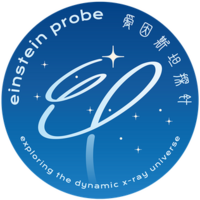Einstein Probe
 Einstein Probe artist impression | |
| Names | Aiyinsitan Tanzhen |
|---|---|
| Mission type | Space observatory |
| Operator | CAS, ESA |
| COSPAR ID | 2024-007A |
| SATCAT no. | 58753 |
| Website | ep |
| Mission duration | 3 years (planned) 11 months and 23 days (ongoing) |
| Spacecraft properties | |
| Spacecraft | Einstein Probe |
| Bus | Phoenix-Eye-2 |
| Manufacturer | CAS |
| Launch mass | 1,450 kg (3,200 lb)[1] |
| Dimensions | 3 × 3.4 m (9.8 × 11.2 ft) |
| Start of mission | |
| Launch date | 9 January 2024, 07:02 UTC[2] |
| Rocket | Long March 2C[2] |
| Launch site | Xichang LC-3 |
| Contractor | CASC |
| Orbital parameters | |
| Reference system | Geocentric orbit |
| Regime | Low Earth orbit |
| Perigee altitude | 581 km |
| Apogee altitude | 596 km |
| Inclination | 29° |
| Period | 96 minutes |
| Instruments | |
| Wide-field X-ray Telescope (WXT) Follow-up X-ray Telescope (FXT) | |
 Einstein Probe Logo | |
The Einstein Probe (EP) is an X-ray space telescope mission by Chinese Academy of Sciences (CAS) in partnership with European Space Agency (ESA) and the Max Planck Institute for Extraterrestrial Physics (MPE) dedicated to time-domain high-energy astrophysics.[3][4] The primary goals are "to discover high-energy transients and monitor variable objects".[5] The telescope was launched by a Long March 2C rocket from the Xichang Satellite Launch Centre in China, on 9 January 2024, at 07:03 UTC.[6]
Scientific objectives
[edit]The primary science objectives are:[7]
- Identify inactive black holes to study how matter is precipitated there by detecting the transient events that take the form of X-ray flares;
- Detect the electromagnetic counterpart of events triggering gravitational waves such as the merger of neutron stars which will be discovered by the next generation of gravitational wave detectors;
- Carry out permanent monitoring of the entire sky to detect the various transient phenomena and carry out measurements of known variable X-ray sources.
Instruments
[edit]Einstein Probe carries 2 scientific instruments: the Wide-field X-ray Telescope (WXT), and the Follow-up X-ray Telescope (FXT).[8] Both telescopes utilize X-ray focusing optics.
- Wide-field X-ray Telescope (WXT): WXT has a new optics design, called "lobster-eye", that has wider field of view.[4][8] "Lobster-eye" optics was first tested by the Lobster Eye Imager for Astronomy (LEIA) mission, launched in 2022.[4][9][10] WXT consists of 12 Lobster-eye optics sensor modules, together creating a very large instantaneous field-of-view of 3600 square degrees. The nominal detection bandpass of WXT is 0.5~4.0 keV. Each module weighs 17 kg and has an electrical power consumption of just under 13 W. With the peripherals, the entire telescope weighs 251 kg and has a power consumption of 315 W.
- Follow-up X-ray Telescope (FXT): FXT has optics adopted from eROSITA, "the mirror module consists of 54 nested Wolter mirrors with a focal length of 1600 mm and an effective area of greater than 300 cm2 at 1.5 keV."[8]
The probe weights 1450 kg and is 3-by-3.4 metres.[4]
Launch
[edit]Einstein Probe was launched on 9 January 2024, at 07:03 UTC by a Long March 2C rocket from the Xichang Satellite Launch Centre in China, and successfully placed in low Earth orbit at an altitude of 600 km[2] and an inclination of 29 degrees, giving an orbital period of 96 minutes.[11]
First results
[edit]CAS reported that EP "performs as expected in the first month".[12] The probe detected fast X-ray transient EP240315a,[13] and bright X-ray flares EP240305a[14] and EPW20240219aa.[15]
See also
[edit]- Timeline of artificial satellites and space probes
- List of things named after Albert Einstein
- X-ray astronomy
- List of space telescopes#X-ray
References
[edit]- ^ "Einstein Probe factsheet". ESA. Retrieved 10 January 2024.
- ^ a b c "Einstein Probe lifts off on a mission to monitor the X-ray sky". www.esa.int.
- ^ "Einstein Probe in a nutshell". www.esa.int. Retrieved 28 December 2023.
- ^ a b c d "Einstein Probe factsheet". www.esa.int. Retrieved 28 December 2023.
- ^ "Einstein Probe Time Domain Astronomical Information Center". ep.bao.ac.cn. Retrieved 28 December 2023.
- ^ Jones, Andrew (January 9, 2024). "China launches "lobster eye" Einstein Probe to unveil mysteries of X-ray universe". spacenews.com.
- ^ "Science Objectives Overview". Einstein Probe. Retrieved 14 January 2024.
- ^ a b c "EinsteinProbe". www.mpe.mpg.de. Retrieved 28 December 2023.
- ^ "Einstein Probe Time Domain Astronomical Information Center". ep.bao.ac.cn. Archived from the original on 28 December 2023. Retrieved 28 December 2023.
- ^ Jones, Andrew (November 25, 2022). "China tests novel 'lobster eye' X-ray telescope for observing cosmic events". Space.com.
- ^ "Technical details for satellite EINSTEIN PROBE". N2YO.com - Real Time Satellite Tracking and Predictions. Retrieved 2024-03-07.
- ^ "Time Domain Astronomical Information Center". ep.bao.ac.cn. Retrieved 13 April 2024.
- ^ "Time Domain Astronomical Information Center". ep.bao.ac.cn. Retrieved 13 April 2024.
- ^ "Time Domain Astronomical Information Center". ep.bao.ac.cn. Retrieved 13 April 2024.
- ^ "Time Domain Astronomical Information Center". ep.bao.ac.cn. Retrieved 13 April 2024.
Further reading
[edit]- Yuan, Weimin; Zhang, Chen; Chen, Yong; Ling, Zhixing (2022). "The Einstein Probe Mission". Handbook of X-ray and Gamma-ray Astrophysics. pp. 1–30. arXiv:2209.09763. doi:10.1007/978-981-16-4544-0_151-1. ISBN 978-981-16-4544-0.
External links
[edit]- Official website
 at NAOC, CAS. Archived January 2, 2022, at the Wayback Machine
at NAOC, CAS. Archived January 2, 2022, at the Wayback Machine - Einstein Probe at ESA.int
- Einstein Probe at MPE.MPG.de
